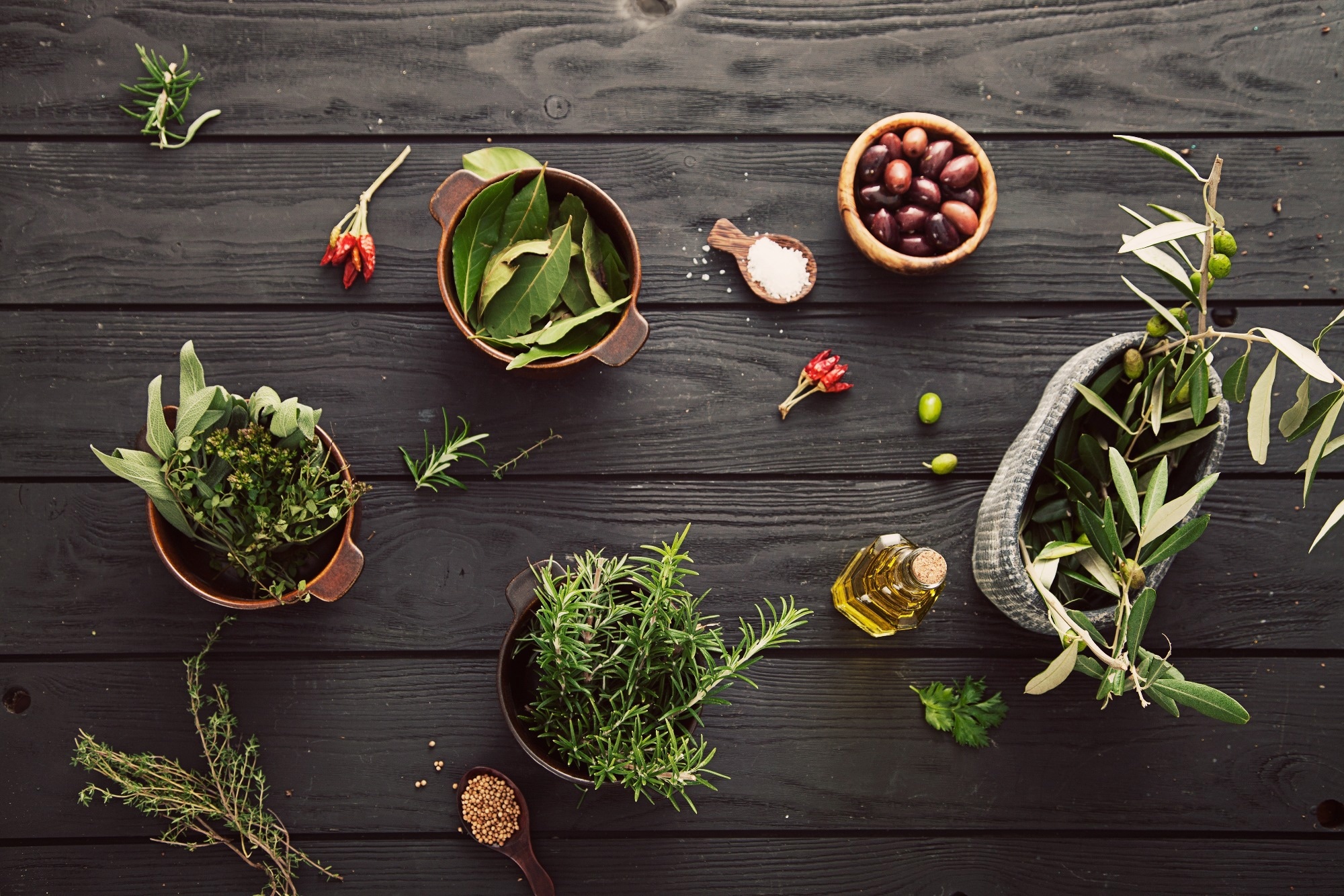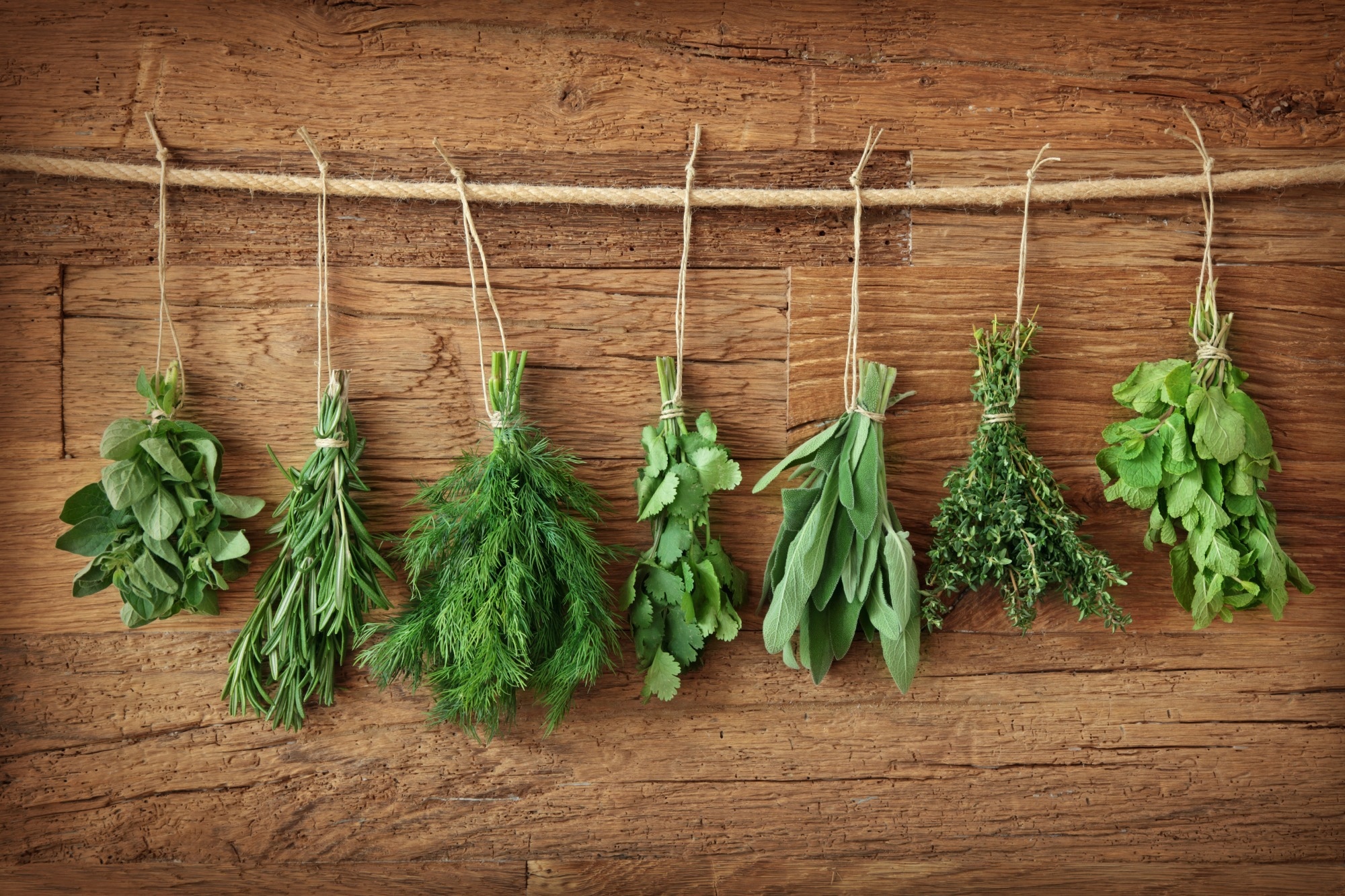Introduction
Phytochemical composition
Antioxidant and anti-inflammatory activity
Antimicrobial and antiviral properties
Metabolic and cardiovascular health
Neuroprotective and anti-cancer effects
Safety, dosage, and application
Conclusions
References
Further reading
Explore the science behind oregano and thyme, two culinary herbs with promising bioactive powers and a growing body of research on their health effects.
 Image Credit: mythja / Shutterstock.com
Image Credit: mythja / Shutterstock.com
Introduction
Culinary herbs are rich sources of bioactive phytochemicals with antimicrobial, antioxidant, anti‑inflammatory, and anti-tumor properties. Oregano (Origanum vulgare) and thyme (Thymus vulgaris) both contain high levels of phenols and terpenoids that contribute to their bold flavor and antioxidant properties. However, the specific ratios of these compounds can vary widely depending on species, growing conditions, and extraction methods. When directly compared in laboratory studies, oregano most often demonstrates higher antioxidant and antimicrobial potency, while thyme excels in certain anti-inflammatory measures and has a unique phytochemical profile.
Phytochemical composition
Oregano is characterized by abundant phenolic monoterpenes like carvacrol, thymol, and rosmarinic acid, as well as flavonoids including luteolin, apigenin, and quercetin. The essential oil fraction of oregano is also rich in diverse terpenoids that enhance antimicrobial and antioxidant potential. The proportions of carvacrol and thymol, in particular, can differ substantially depending on genotype, harvest time, and geographical origin, which is important when comparing different oregano samples.
Thyme exhibits a similar yet distinct profile, as it contains high levels of thymol accompanied by carvacrol, p‑cymene, γ‑terpinene, and borneol. The non‑volatile matrix of thyme supplies thymusin and other luteolin derivatives, as well as saponins and tannins. Thyme chemotypes are also highly variable, with some rich in thymol, others in carvacrol, and the bioactivity can therefore vary between thyme varieties.2
Genotype, soil chemistry, altitude, temperature, irrigation, and harvest timing can modulate secondary metabolite biosynthesis and produce chemotypes rich in either thymol or carvacrol. Post‑harvest techniques may also impact the final product composition, as hydrodistillation favors lighter monoterpenes, supercritical‑fluid extraction can enrich sesquiterpenes, and solvent polarity affects recovery of polyphenols. This variability emphasizes the importance of developing standardized cultivation and extraction methods for reproducible culinary, nutraceutical, and pharmacological applications.2
Antioxidant and anti-inflammatory activity
Essential oils of oregano, thyme, and sage (Salvia officinalis) exhibit potent, antioxidant and anti‑inflammatory effects in diverse experimental systems, including neutralized reactive oxygen species (ROS) confirmed through 2,2‑diphenyl‑1‑picrylhydrazyl (DPPH), 2,2′‑azino‑bis (3‑ethylbenzothiazoline‑6‑sulfonic acid) (ABTS) and ferric‑reducing antioxidant power (FRAP) assays. Across nearly all these antioxidant assays, oregano consistently outperforms thyme, making oregano the stronger antioxidant herb based on current laboratory and food model studies. Oregano oil often displays higher antioxidant capacity in vitro, whereas thyme oil may have comparatively greater anti-inflammatory effects under certain assay conditions.3
Both thyme and oregano oil also downregulate nuclear factor kappa‑light‑chain‑enhancer of activated B cells (NF‑κB) signalling, as well as suppress interleukin‑6 (IL‑6) and tumor necrosis factor‑alpha (TNF‑α). Carvacrol and thymol further inhibit cyclo‑oxygenase‑2 (COX‑2) expression by activating peroxisome proliferator‑activated receptor‑alpha (PPAR‑α) and peroxisome proliferator‑activated receptor‑gamma (PPAR‑γ) to ultimately limit prostaglandin synthesis.3
In vitro, thyme oil acts as a strong soybean lipoxygenase inhibitor, whereas oregano oil reduces monocyte chemoattractant protein‑1 (MCP‑1), vascular cell adhesion molecule‑1 (VCAM‑1), and intercellular adhesion molecule‑1 (ICAM‑1) levels in activated fibroblasts to collectively reduce leukocyte recruitment. Most antioxidant and anti-inflammatory effects described for oregano and thyme are based on in vitro and animal studies; there is limited direct evidence from human clinical trials. Nonetheless, oregano’s dominance in antioxidant capacity is consistent across multiple studies and assay systems.3
Antimicrobial and antiviral properties
Essential oils from oregano and thyme exhibit broad antimicrobial activity that is largely attributed to the activity of phenolics like carvacrol and thymol that disrupt bacterial membranes. In vitro, thyme and oregano oils inhibited major food‑borne bacteria including Escherichia coli, Staphylococcus aureus, methicillin‑resistant S. aureus (MRSA), Salmonella Enteritidis, Salmonella Typhimurium, and Bacillus cereus, with oregano almost always providing a stronger and more consistent antimicrobial effect than thyme. This has been confirmed by direct side-by-side comparison studies using equivalent doses of both herbs’ oils or extracts. The effectiveness of these essential oils may depend on the bacterial strain and the precise chemical composition of the oil used.
Mechanistically, these compounds increase membrane permeability and deplete cellular energy, which leads to growth suppression or killing. Laboratory studies have reported that combining essential oils with conventional antimicrobials can enhance inhibition, suggesting potential synergy and dose‑sparing effects in vitro. While in vitro antiviral activity has been reported for essential oil constituents, well-controlled clinical studies on antiviral efficacy in humans are currently lacking.4
How to Cleanse Your Lungs with Oregano and Thyme Essentials Oils
Metabolic and cardiovascular health
Carvacrol and thymol in oregano essential oil support healthy glucose levels, improve insulin sensitivity, as well as maintain healthy total cholesterol, triglycerides, and low‑density lipoprotein levels. These properties can be attributed to adenosine monophosphate-activated protein kinase (AMPK), a cellular switch that supports fat burning and encourages muscles to utilize sugar as an energy source. However, most evidence for these metabolic effects comes from animal studies or in vitro research, and direct benefits in humans have not been fully established. Oregano has shown somewhat stronger anti-obesity and metabolic benefits in animal models compared to thyme, although both herbs possess relevant activity.
Polyphenols and terpenoids in thyme relax vascular smooth muscle, support endothelial nitric oxide signaling, and lower peripheral resistance. The flavonoid fraction of thyme also exhibits antithrombotic activity by inhibiting platelet activation and aggregation, in addition to modulating thromboxane pathways to potentially reduce prothrombotic risk. As with oregano, most of the available data are preclinical, and additional human studies are needed to confirm these findings. Thyme may be more effective than oregano for certain vascular and platelet-related effects, particularly those related to endothelial function and anti-thrombotic action.
These mechanisms suggest synergy, with oregano targeting metabolic efficiency and adiposity, whereas thyme promotes hemodynamic stability and thromboresistance. Although human trials are limited, culinary or standardized preparations of these herbs, alongside a balanced diet and exercise, could complement conventional strategies for cardiometabolic risk reduction. Further clinical research is necessary to determine their effectiveness and safety in long-term human use.5
Neuroprotective and anti-cancer effects
In rodent stroke models, carvacrol reduces lipid peroxidation and supports the activity of both glutathione‑peroxidase‑4 and superoxide dismutase to reduce oxidative stress. Carvacrol also blocks transient receptor potential cation channel subfamily M member 7 (TRPM7)‑mediated zinc entry, which prevents apoptosis and microglial activation. In rat pheochromocytoma 12 (PC12) neurons, carvacrol downregulates protein kinase B (Akt) and mechanistic target of rapamycin (mTOR) signalling, thereby preventing caspase 3‑driven deoxyribonucleic acid (DNA) fragmentation.6
Oregano‑derived carvacrol reduces mitochondrial membrane potential, inhibits matrix metalloproteinase‑2/9 (MMP‑2/9), and enforces mitogen‑activated protein kinase (MAPK)‑dependent gap 2/mitosis (G2/M) arrest, all of which have been associated with reduced proliferation of human colon adenocarcinoma (LoVo) and colorectal carcinoma (HCT‑116) cells. Similarly, oregano essential oil has been shown to suppress skin tumor biomarkers in human keratinocytes.Animal and cell studies generally show oregano’s carvacrol as more potent than thyme’s main constituents in neuroprotection and anti-cancer actions, but both herbs exhibit significant promise.6
Similar anti-cancer effects have been reported on thyme, as thymol-rich oil activates PPAR-alpha/gamma and represses COX-2 to reduce inflammation-linked oncogenesis. Co‑delivery of carvacrol with thyme constituents further decreases MMP‑2/9 expression in B‑cell lymphoma 2 (Bcl‑2) and colon cancer cells, revealing synergistic stress‑response modulation. Most evidence for anti-cancer and neuroprotective effects is currently derived from in vitro or animal models; confirmation in human subjects is still needed.6
 Image Credit: Elena Schweitzer / Shutterstock.com
Image Credit: Elena Schweitzer / Shutterstock.com
Safety, dosage, and application
Essential oils obtained from oregano, thyme, and related Lamiaceae species are considered safe when ingested at typical culinary levels, a status reflected in the U.S. Food and Drug Administration’s Generally Recognized as Safe (GRAS) list. Nevertheless, undiluted or highly concentrated preparations may irritate oral/gastric mucosa or provoke contact allergies, which supports the need for appropriate dilution or encapsulation. People with allergies to Lamiaceae plants, young children, pregnant or breastfeeding women, or those with chronic medical conditions should seek medical advice before using high-dose essential oils.7
In the HerbELICO® program, soft‑gel and powder‑filled capsules each supplied 65 mg of blended savory, oregano, and thyme oils. Herein, study participants received 260 mg daily for 15 days, following which they reduced their dose to 130 mg for an additional month. This protocol is based on small-scale clinical studies and may not be appropriate for all users or products.
Outside of clinical trial settings, essential oils can be administered as teas, tinctures, aerosols, or enteric‑coated drops, with dose schedules adjusted to product strength and patient tolerance. Long-term safety data on concentrated oil supplementation are limited, and adverse effects can occur if recommended doses are exceeded.
Conclusions
Based on current scientific evidence, oregano generally offers stronger antioxidant and antimicrobial effects than thyme, while thyme may surpass oregano in certain anti-inflammatory and vascular benefits. For neuroprotective and anti-cancer properties, oregano again appears somewhat more potent, largely due to its higher carvacrol content. Both herbs provide health-promoting bioactives and can be used synergistically, but oregano is the superior choice for antioxidant and broad-spectrum antimicrobial activity. Further human research is still needed to confirm these findings in clinical settings.
References
- Grigore-Gurgu, L., Dumitrașcu, L., & Aprodu, I. (2025). Aromatic herbs as a source of bioactive compounds: An overview of their antioxidant capacity, antimicrobial activity, and major applications. Molecules. 30(6). DOI:10.3390/molecules30061304, https://www.mdpi.com/1420-3049/30/6/1304
- Pilozo, G., Villavicencio-Vásquez, M., Chóez-Guaranda, I., Murillo, D.V., Pasaguay, C.D., Reyes, C.T., Maldonado-Estupiñán, M., Ruiz-Barzola, O., León-Tamariz, F. and Manzano, P. (2024). Chemical, antioxidant, and antifungal analysis of oregano and thyme essential oils from Ecuador: Effect of thyme against Lasiodiplodia theobromae and its application in banana rot. Heliyon. 10(10). DOI:10.1016/j.heliyon.2024.e31443, https://www.sciencedirect.com/science/article/pii/S2405844024074747
- Sidiropoulou, E., Marugán-Hernández, V., Skoufos, I., Giannenas, I., Bonos, E., Aguiar-Martins, K., Lazari, D., Papagrigoriou, T., Fotou, K., Grigoriadou, K., Blake, D. P., & Tzora, A. (2022). In Vitro Antioxidant, Antimicrobial, Anticoccidial, and Anti-Inflammatory Study of Essential Oils of Oregano, Thyme, and Sage from Epirus, Greece. Life. 12(11). DOI:10.3390/life12111783, https://www.mdpi.com/2075-1729/12/11/1783
- Boskovic, M., Zdravkovic, N., Ivanovic, J., Janjic, J., Djordjevic, J., Starcevic, M., & Baltic, M. Z. (2015). Antimicrobial activity of thyme (Tymus vulgaris) and oregano (Origanum vulgare) essential oils against some food-borne microorganisms. Procedia Food Science. 5. 18-21. DOI:10.1016/j.profoo.2015.09.005, https://www.sciencedirect.com/science/article/pii/S2211601X15000954
- Shang, W., Li, X.H., Zeng, L.H., Li, Z., Hu, Y., Wen, H.M., Cao, F.J. and Wan, G.X., (2025). Mechanistic Insights into Flavonoid Subclasses as Cardioprotective Agents Against Doxorubicin-Induced Cardiotoxicity: A Comprehensive Review. Drug Design, Development and Therapy. 5553-5596. DOI:10.2147/DDDT.S535517, https://www.dovepress.com/mechanistic-insights-into-flavonoid-subclasses-as-cardioprotective-age-peer-reviewed-fulltext-article-DDDT
- Imran, M., Aslam, M., Alsagaby, S. A., Saeed, F., Ahmad, I., Afzaal, M., Arshad, M. U., Abdelgawad, M. A., El-Ghorab, A. H., Khames, A., Shariati, M. A., Ahmad, A., Hussain, M., Imran, A., & Islam, S. (2022). Therapeutic application of carvacrol: A comprehensive review. Food Science & Nutrition. 10(11). 3544–3561. DOI:10.1002/fsn3.2994, https://onlinelibrary.wiley.com/doi/full/10.1002/fsn3.2994
- Nikolić, I., Chua, E. G., Tay, A. C. Y., Kostrešević, A., Pavlović, B., & Jončić Savić, K. (2023). Savory, Oregano and Thyme Essential Oil Mixture (HerbELICO®) Counteracts Helicobacter pylori. Molecules. 28(5). DOI:10.3390/molecules28052138, https://www.mdpi.com/1420-3049/28/5/2138
Further Reading
Last Updated: Aug 4, 2025